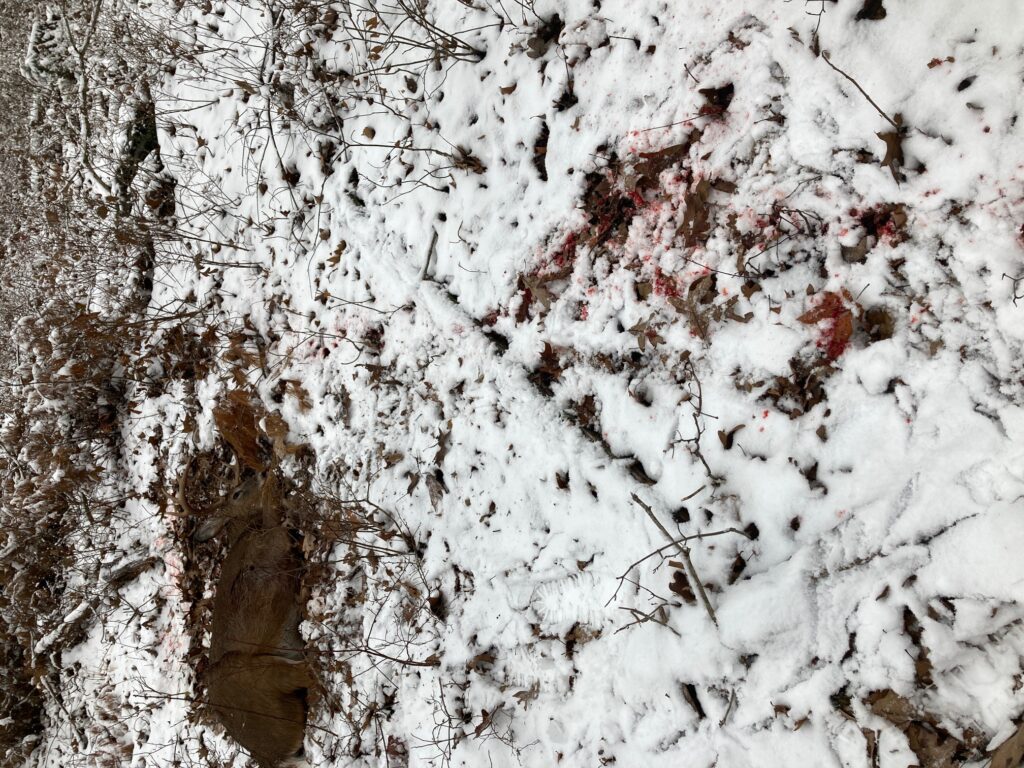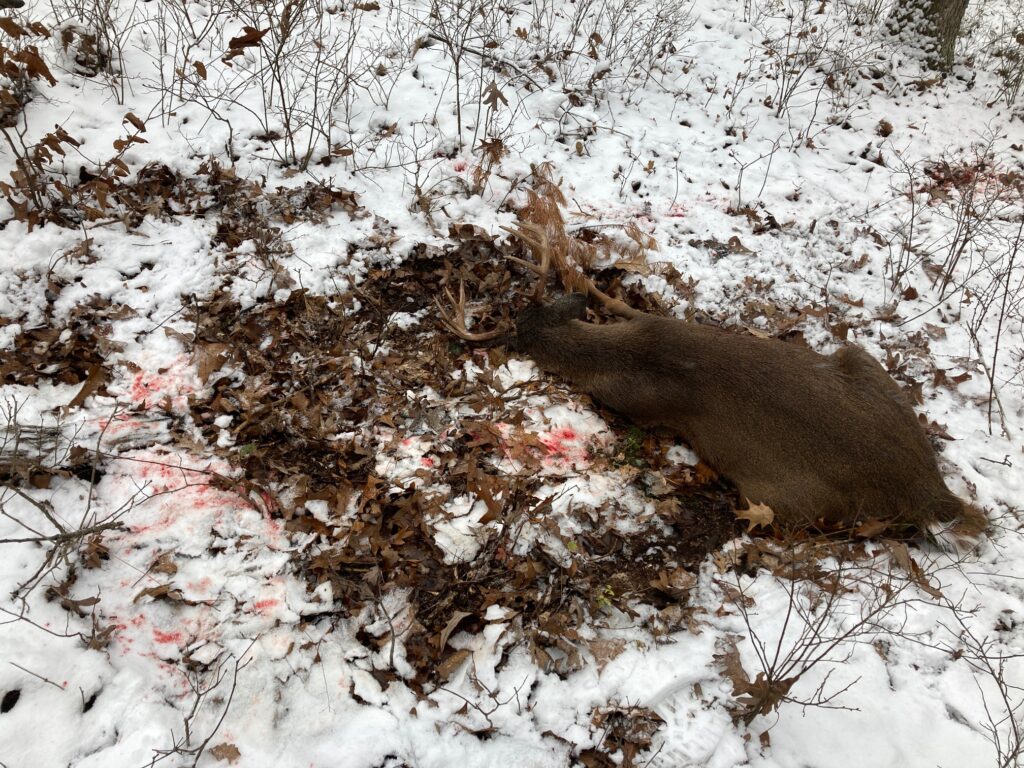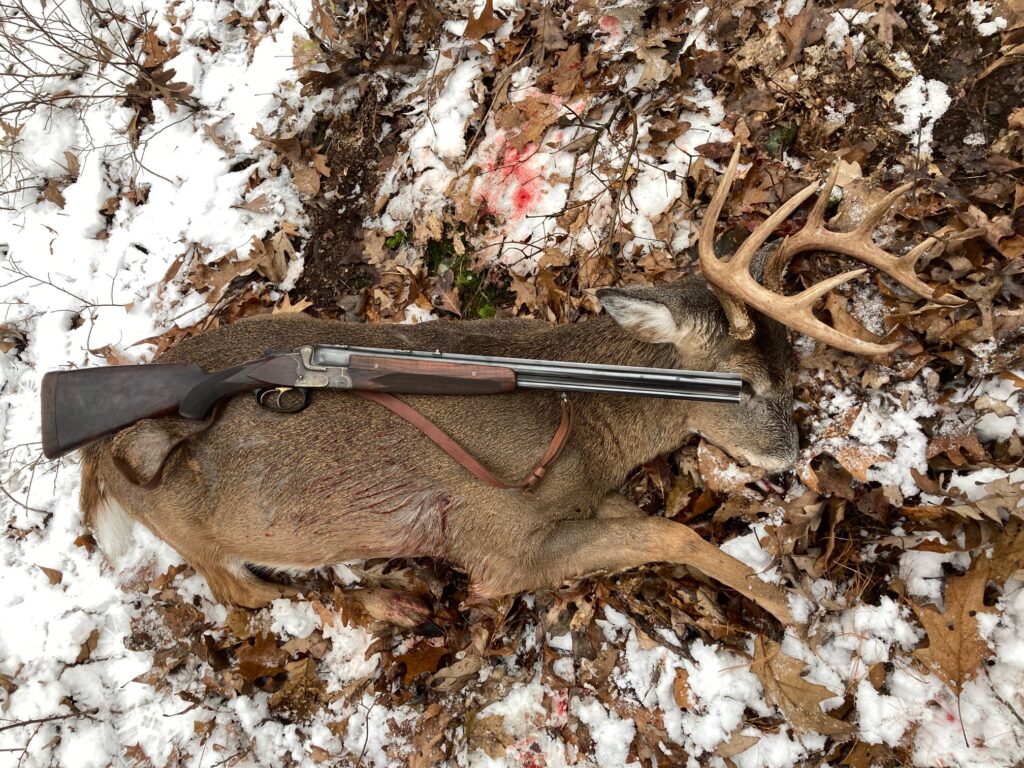Posts Tagged → blood
The deer that got away, but shouldn’t have
Below is the buck after the second bullet, at about 140 yards, the hole of which is visible behind his shoulder; a classic behind-the-shoulder double lung/ top of heart hit. Usually it’s immediately fatal. Usually the animal is knocked down by the impact. But not that day. He absorbed the second soft point without moving, just standing there broadside, as if I had completely missed him. Even after he dropped he had a lot of life and fight left, as can be seen in his death spiral in the snow.

My challenge was that I did not see him fall, which happened while I was fumbling with my binoculars. Because I do not often use a rifle scope, I do not maintain a magnified field of view after my shot. Going back and forth between open sights and binoculars is my process.
As an aside, you may wonder why I use open sights, or you may be one of those people who deride open sights. Shooting instinctively with open sights is how I grew up and how I learned to hunt. Unlike a scope, open sights can take a lot more abuse in the field before they go out of whack. Unlike a scope, they cannot possibly lose their “zero” after spending eleven months in a closet. Open sights are absolutely reliable, and perfectly effective. Recall that American infantry are qualified on open sights out to 600 yards (or meters), so it is not like these things are relics from the past. Open sights are the best option, provided they are installed correctly and checked annually.
My preference for open sights is about more than performance, however. It has to do with how I like to hunt: On foot, getting close to the animal, within its sensory zone, and trying to kill it on its own terms, up close. This is a true contest of skill, not an assassination. And I hardly think an open-sighted center fire rifle is a disadvantage; it is a huge advantage over a spear or a bow. Scoped rifles are just that much more of an advantage.
So, I did not see the buck fall, and he fell into a small swale where I could not see him. Not wanting to stink up the woods and ruin further hunting, I sat on my butt and scoured the woods for signs of a deer. In fact, I saw a large buck a couple hundred yards away sneak into a thick tree top blowdown. It made me think the buck I had shot at was gut-shot and sneaking away to lie down, and so I did not push him. Only when the crows showed up over an hour later was it evident that the buck was in fact dead right where I had last seen him.
Time to create Kurdistan out of Iraq
Now that a slim majority of the Iraqi parliament has voted to demand the full exit of American everything from Iraq, it is time for America, the liberator and vanquisher of Iraq, to decide what to do next.
Note that Iraq is roughly 60% Shia Muslim, who identify closely with Shia-majority Iran. That 60% of Iraq’s population lives in a relatively small region adjoining Iran, and despite holding such a small geographical area, about 15% of Iraq’s surface area, the population dominates the entire country.
One of the enormous mistakes made by the Bush administration when invading Iraq were these assumptions: 1) Iraqis will welcome Americans as liberators the same way Europeans welcomed American GIs in World War II; 2) Iraqis will be forever grateful for America’s liberation of Iraq, and they will therefore become a key ally in the region; 3) Iraq was, is, and will be fertile ground for planting western-style democracy, thereby creating some form of democratic government that will naturally cooperate with America and other Western nations.
These assumptions were rightly questioned at the time of the Iraq invasion, and they were further questioned during the occupation and subjugation of the native jihadis there. In recent years a kind of quiet war of careful positioning has followed, and so the newest assumption was that America had been successful in all ways, and had brought lasting peace to Iraq. And so, the thinking has gone, America can just pull up stakes and move everyone back home.
Not so fast.
Being anti-war is understandable if it applies to unjust wars, unwarranted wars, stupid wars, wasteful wars, and artificially inhibited wars, all of which applied up front to the American invasion of Iraq and then the occupation. Perhaps the most dispiriting aspect of the Iraq occupation was the ridiculous “rules of engagement,” created by Bush and further tightened by Obama, whereby our own troops pretty much had to bleed before they were allowed to return fire against aggressors. These insanely restrictive rules of engagement inhibited American forces from doing their job effectively, quickly, and safely. These rules led to years of IEDs and snipers killing and badly wounding American military personnel who were in Iraq to bring peace and prosperity to Iraqis, and to an anti-warrior culture at the Pentagon back home, whereby devoted fighters like Navy SEAL operations chief Edward “Eddie” Gallagher were often held to impossibly impractical standards for conduct on the field of battle against merciless enemies. And then made an example of by desk jockeys and armchair generals.
Almost all of those IED and sniper attacks on American forces could have been prevented by having either no rules of engagement, or rules of engagement that greatly and quite naturally favored the interests of our forces over vague concerns about perceptions and lingering “feelings” of Iraqis.
However, the rules of engagement stayed on and what was done was done; now twenty years later, America has spent trillions of taxpayer dollars and tanker trucks of American blood to bring peace and prosperity to yet another group of Middle East/Near East/ Muslim people who really don’t value peace and prosperity, nor democracy, either. None of these things that Americans and Europeans value are valued by Muslims, plain and simple. This is proven by the lack of peace, the lack of prosperity, and the lack of democracy or the rule of law in every..single…Muslim country.
So now that the vanquished are demanding that the conqueror leave Iraq, what should America do?
Our main options are to stay and fight all over again, or to appease the Iraqi government, which is now largely a Shia proxy of Iran’s theocracy, or to turn and leave.
Staying and fighting is unappealing, because we did that already, at great cost. The “no blood for oil” cries of the initial invasion were prophetic, as America stupidly declined to take any payment of any sort for our efforts. Not even in abundant Iraqi oil, which could have been easily and fairly shipped home to offset our huge investment in Iraq’s freedom and stability.
Appeasing the Shia-led Iraqi government is also unappealing and impractical, as appeasement never works, it just delays the inevitable conflict while our enemy prepares overtime for violent conflict. Thus prolonging the inevitable.
Finally, America can turn and leave, pulling up stakes and bidding farewell to Iraq with a “pox on your house” tossed over our shoulder as we send everyone home. This option has the greatest emotional appeal, and for good reason: Those who love and cherish American military personnel are loathe to see them sacrificed once again or any longer in the pursuit of vague, poorly defined, or improbable geopolitical goals. And the oil-less Iraq war and occupation was nothing if not poorly defined with vague, improbable goals at huge cost. But leaving cold turkey is a terrible option, because it will mean America invested trillions of dollars and thousands of wonderful young men for nothing. Not even for oil, and yet we will be in a worse position than we were when we first invaded.
A fourth option exists, and will take some creativity to implement. But it is doable, and is the best of all our options, because it allows America to meet all of its geopolitical and strategic goals at minimal cost to our servicemen and taxpayers.
This fourth option is to subdivide Iraq into new states, based on ethnicity and or religious makeup. Similar to how Pakistan was created out of India in 1948.
We will support those new states that share our interests, and we will harass and undermine those states that ally themselves with our sworn enemies, like Iran (and yes, theocratic Iran has been America’s sworn enemy long before Israel had a dog in that fight). Thus, breaking up Iraq into Sunni, Shia, and Kurdish states will allow us to more easily identify and help our friends, and more easily isolate and fight our enemies. It will take the vast majority of Iraq’s Shia Muslims and keep them in the smallest geographical area of Iraq where they already live. It will also enable America to finally begin to take payment from the vast oil fields that are mostly surrounded by pro-America Kurds. Most of Iraq’s geography is already divided up along ethnic and sectarian lines, so the new state lines on the map can be pretty easily drawn to match.
By creating the modern Kurdistan, America will implement several goals. First, we will be placing most of the existing oil fields in the hands of a people who have been and who still are naturally inclined to ally with America. America will benefit from the oil not going to Iran, and we can always set up a long-overdue financial debt repayment program with the Kurds, in oil or in oil receipts.
Second, we will be undermining two of the most dangerous states in the region, Iran and Turkey, both of whom have openly demonstrated clear goals of regional domination at any cost and with any method. Recall that Turkey has been quietly allied with ISIS, and also has been openly in pursuit of genocide against the Kurds while lusting after their oil fields. Iran’s ideological threat needs no explanation, as they openly wish to explode many nuclear bombs across America, and for years they have been quietly exploiting our open southern border in preparation to do just this.
In the spirit of the times, I propose the creation of Shiastan (capital city of Najaf), Sunnistan (capital city of Baghdad), and Kurdistan (capital city of Kirkuk) in response to Iraq’s declaration of war against America.
409+
Last week, under pressure to perform at an adult, professional level, the senior staff at the NCAA folded right before appearing in court.
The discovery phase of a lawsuit brought against the NCAA for its disproportionate over-correction of Penn State University was about to begin, and with a handful of damning NCAA emails already in hand, the meaty part of discovery would have exposed the heavy handed NCAA overlords for what they are: Incompetent, vacuous bullies.
The fictional Louis Freeh “report” aka Hit Piece and Flaming Bomb Meant to Humble Penn State has gradually yielded to the collective bits of disbelief and basic deductive logic surrounding the Joe Paterno Assassination aka The Oxbow Incident.
Knowing now what we already knew two years ago, the NCAA storm trooper and tactical nuke assault on one of the very few pristine colleges in the nation has blown up in the NCAA’s own face.
Yes, we got our 409 wins back, but we deserve so much more.
And to have undergone so much knee-jerk reaction injustice…..Penn State deserves compensation, to be made whole, to get back what we lost, if it’s remotely possible.
I want blood.
I want guts.
I want a shred of public justice for Joe Paterno and Penn State, and for the student athletes immorally saddled with faux guilt from the sick, distant actions of a man they’d never met, let alone heard of (Jerry Sandusky).
To begin with, the Joe Paterno statue immediately goes back to its original prominent place on campus.
Then, every member of the PSU board involved in the debacle issues a personal, hand written apology. And then each resigns. I’ve got a few names to go with that demand.
Then each NCAA staff member associated with the debacle issues a hand written apology, and then resigns.
That’s what real leaders do when they fail badly.
And for those folks who really want to demonstrate their earnest attitude, I’ve got some old Japanese swords you can fall on. I’m tempted to serve as your second….to ensure a clean ending, of course.
A clean ending to a tragedy, a failure to protect little boys, a failure to act like grown men and women and apply justice carefully, a failure to protect the grown boys on the team and the many professional educators and students unfairly tarnished by the NCAA’s hasty, shoot-first-ask-questions-never attitude.
And then there’s the scholarships, the bowl money PSU lost. The opportunities unfairly crushed. How do we get all that back?
And Mr Louis Freeh, you may be ex-FBI, but I’m ex-Penn State Nittany Lion. Don’t meet me in a dark alley.



